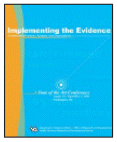State of the Art (SOTA) Conferences
SOTAs bring together an invited multidisciplinary group of VA and non-VA experts to:
- Synthesize what we know and what we need to know about topics critical to the health and
well-being of veterans;
- Promote implementation of findings that improve quality of care; and
- Contribute to more effective management and more relevant research.
A variety of post-conference products are developed to disseminate the
conference findings and recommendations throughout the VA system, and
often to the non-VA health care community.
Contact
Karen Bossi, MA
Associate Director, CIDER
E-mail: Karen.Bossi@va.gov
Past State of the Art (SOTA) Conferences

SOTA 19: Nursing Research Agenda
Goals
The VHA Nursing Workforce Strategic Plan is focused on four pillars with specific strategies to ensure a strong nursing workforce to meet the four statutory missions of the VA. These four pillars are:
1) Optimizing and informing nursing practice
2) Strengthening the nursing workforce
3) Reimagining lifelong learning and career development
4) Inspiring an Industry-leading Culture.
To further the Strategic Plan, the purpose of the Nursing Research Agenda SOTA was to develop a research agenda that can optimize nursing practice and strengthen the nursing workforce to inspire an industry leading culture in VA. The goal of this national invitation-only conference was to identify what we know (existing evidence) and what we need to know about nursing research and implementation.
Work Groups
- Optimizing Nursing Practice
- Nursing Workforce Management and Staffing
- Nursing Environment/Culture
top

SOTA 18: Measuring What Matters Most: Whole Person Outcomes
Goals
- To summarize what we know and need to know about whole-person outcome measures in 3 areas:
- clinical care
- tracking population health
- designing research
- To identify evidence-based measures ready for wider dissemination and implementation, including identification of barriers to use and approaches for overcoming barriers
- To identify a research agenda that can lead to increasing use of evidence-based measures and to make recommendations for policy as appropriate
- To disseminate SOTA findings and recommendations
Meeting Summary
Outcomes/Products:
The VA Evidence Synthesis Program conducted several evidence inventories to inform discussions at the conference:
- Evidence Inventory - Whole Person Outcome Measurement in Treatment-Outcomes and Health Status Research (vaww.hsrd.research.va.gov/publications/esp/whole-person-sota.cfm - intranet only)
- Evidence Inventory- Health Systems Research on Measurement and Use of Whole Person Outcomes (vaww.hsrd.research.va.gov/publications/esp/evidence-inventory-wpo.cfm - intranet only)
DRAFT priorities and recommendations from each of the priority area work groups are available here.
Please note that these are draft documents and may not represent the final recommendations that will be forthcoming.
top

SOTA 16: State of the Art Conference on VA Emergency Medicine (SAVE)
January - February 2022 (virtual)
Goals
- To summarize what we know and need to know about evidence-based emergency medicine care, specifically addressing:
- Emergency Care for Acute Mental Health Conditions (e.g., suicide prevention, substance use disorder, access: telehealth, transfer, timely mental health care)
- Emergency Care for Older Veterans (e.g., polypharmacy/medication safety, delirium recognition, falls risk assessment, effective models of geriatric emergency care)
- Emergency Care Provided in the Community (e.g., quality/costs of community care, impact of expanded access to community urgent care [MISSION Act] and patterns of use)
- To identify evidence-based approaches ready for wider dissemination and implementation, including identification of barriers and approaches for overcoming barriers
- To identify a research agenda that can lead to increasing use of evidence-based approaches in emergency medicine and to make recommendations for policy as appropriate
- To disseminate SOTA findings and recommendations
Outcomes/Products:
The VA Evidence Synthesis Program conducted several evidence reviews to inform discussions at the conference:
- Evidence Compendium: Effectiveness of Mental Health Interventions in the Emergency Department
https://vaww.hsrd.research.va.gov/publications/esp/mental-health-interventions-compendium.cfm (intranet only)
- Evidence Map: Implementation Factors Influencing the Transition from Emergency to Outpatient Care Settings
- Evidence Inventory: Emergency Department-based Geriatric Risk Assessment
https://vaww.hsrd.research.va.gov/publications/esp/geriatric-risk-assess.cfm (intranet only)
- Evidence Inventory: Emergency Department-based Telehealth Interventions for Older Adults
https://vaww.hsrd.research.va.gov/publications/esp/telehealth-older-adults.cfm (intranet only)
- A special issue of Academic Emergency Medicine was published in April 2023 that includes 23 manuscripts and addresses key research and operational priorities identified during the SOTA conference.
Research Priorities and Recommendations
In addition to the need for research for Veteran emergency care in general, three specific high priority focus areas were identified from the SOTA including older Veterans, Veterans with mental health needs, and emergency care in community (non-VA) settings.
- Older Veterans. Among older Veterans, priorities include: examination of variation in care and its impact on patient outcomes, utilization, and costs; quality of ED care transitions and strategies to improve them; impact of Geriatric Emergency Department (ED) care improvement initiatives; and use of geriatric assessment tools in the ED.
- Veterans with Mental Health Needs. For Veterans with mental health needs, priorities include: examination of variation in staffing and delivery models and its impact on patient outcomes, utilization and costs, such as embedding mental health staff in EDs; enhancing staff retention and recruitment; examination of geographic differences in care; improving the implementation of mental health and substance use screening along with evidence-based interventions in a Veteran and provider-centric manner.
- Community care. Community (non-VA) emergency care priorities included: examining changes in patterns of use and costs in VA and community care (CC) as a result of recent policy and coverage changes (with an emphasis on modifiable factors); understanding quality, safety, and Veteran experience differences between VA and CC settings; and better understanding follow-up needs among Veterans who have received CC emergency care (or urgent care), and how well are those needs being coordinated, communicated, and met.
Telehealth was further identified as a priority for both older Veterans and those seeking access to emergency mental health care including the quality, safety, and effectiveness of telehealth at the point of care for access to specialty care during acute emergencies.
More details about the priorities and recommendations from each of the priority area Workgroups is available here. Please note that these are draft documents and may not represent the final
recommendations that will be forthcoming:
for older Veterans, Veterans with Mental Health Needs, and Community Care .
top
SOTA 15: Opioid Safety

September 11-12, 2019
Goals:
- Reach consensus on policy recommendations to improve management of pain and addiction and improve opioid safety
a. Where is the evidence sufficient to move to implementation?
- Reach consensus on recommendations for research agenda
a. What important questions do not have sufficient evidence to guide practice and clinical policy?
- Prioritize issues for future consideration
a. What issues or new developments are on the horizon that may need to be considered in research, planning, and policy?
Outcomes:
- The VA Evidence Synthesis Program conducted three evidence reviews to inform discussions at the conference and three related cyberseminars:
- Workgroup slides:
- Briefing of conference policy recommendations to Mental Health leadership.
- A special supplement to the Journal of General Internal Medicine was published in December 2020.
Table 1 Implementation and Policy Recommendations
From: Implementation and Policy Recommendations from the VHA State-of-the-Art Conference on Strategies to Improve Opioid Safety
|
Goal
|
Specific recommendations
|
|---|
|
Managing opioid use disorder
|
|
1. Increase access to MOUD
|
- Provide same-day access to MOUD at every VHA facility and support medical management of OUD across clinical settings
- Ensure that psychosocial treatment is available but not a pre-requisite for medication treatment
- Clarify regulations around tele-prescribing of MOUD
- Mandate overdose event reporting with the Suicide Behavior and Overdose Report and require timely follow-up following an overdose
|
|
2. Improve provider knowledge and comfort to provide MOUD
|
- Develop national SUD consultation program modeled after e11sting VHA programs in PTSD and suicide risk management
- Disseminate provider and patient educational resources
|
|
3. Improve fidelity to evidence-based models of MOUD
|
- Standardize monitoring of substance use during OUD treatment
- Replace administrative discharges for substance use with evidence-based treatment of co-occurring SUDs
|
|
Long-term opioid therapy and opioid tapering
|
|
1. Support evidence-based, patient-centered approaches to opioid therapy and opioid tapering
|
- Avoid initiation of high-dose long-term opioid therapy for chronic pain
- Individualize assessment of risks and benefits and individualize implementation of opioid dose reduction
- Align communication about VHA policy for Veterans, their families/caregivers, healthcare teams and leadership
|
|
2. Provide system-wide access to team-based care
|
- Offer multidisciplinary care with more frequent follow-up during opioid dose reduction
|
|
3. Ensure access to assessment and treatment for OUD
|
- Recommend against abrupt discontinuation of opioid medications due to concern for OUD without facilitating transition to OUD treatment
|
|
Managing co-occurring pain and substance use disorder
|
|
1. Improve access to evidence-based non-pharmacologic treatments
|
- Disseminate evidence-based combined psychological interventions for co-occurring disorders
- Disseminate evidence-based interventions for chronic pain (e.g., cognitive behavioral therapy, movement therapies)
|
* MOUD, medications for opioid use disorder; OUD, opioid use disorder; PTSD, post-traumatic stress disorder; SUD, substance use disorder; VHA, Veterans Health Administration
top
SOTA 14: Care Coordination

March 20-21, 2018
Goals:
1. To summarize what we know and need to know about care coordination specifically addressing:
- Coordination of Care within VA
- Coordination of Care from VA to non-VA care
- Measures, Models, and Definitions
2. To identify approaches ready for wider dissemination and implementation, including identification of barriers and approaches for overcoming barriers
3. To identify a research agenda that can lead to increasing use of evidence-based approaches to coordination of care and to make recommendations for policy as appropriate
Outcomes:
- The VA Evidence Synthesis Program conducted a Rapid Evidence Review of care coordination theoretical models and conceptual frameworks to inform the work of the Measures, Models, and Definitions work group.
- A special supplement to the Journal of General Internal Medicine was published in May 2019.
top
SOTA 13: Non-pharmacological Approaches to Chronic Musculoskeletal Pain Management

November 3-4, 2016
Goals:
To identify the state of the art by clarifying what we know and what we need to know about non-pharmacological approaches to chronic musculoskeletal pain management specifically,
- psychological/behavioral therapies,
- exercise/movement therapies,
- manual therapies and,
- models for delivery of multi-modal pain care.
Four work groups made up of VA and non-VA subject matter experts addressed the following:
- Where is the evidence sufficient to move to implementation?
- Reach consensus on priorities and develop recommendations for policy and strategies to assist VA and the larger health care community to improve implementation.
- What important questions do not have sufficient evidence to guide practice and clinical policy?
- Reach consensus on recommendations for research and develop a research agenda to address knowledge gaps.
- What issues or new developments are on the horizon that may need to be considered in research, planning, and policy?
- Prioritize issues for future consideration.
- Recommend strategies for dissemination and implementation of SOTA findings.
Outcomes/Products
- The VA Evidence Synthesis Program conducted a Rapid Evidence Review of Measures to inform the work of the Measurement work group. This document is available on the intranet only. If you have intranet access, copy and paste vaww.hsrd.research.va.gov/publications/esp/chronicpain-measures.cfm into your browser.
- An evidence brief was published by the VA Evidence Synthesis Program, titled Effectiveness of Models Used to Deliver Multimodal Care for Chronic Musculoskeletal Pain, and was used to inform initial discussion of the Models of Care work group during the conference.
- Formed a Measurement work group to develop recommendations for pain outcome measures to be used in interventional or observational research studies. Kroenke K, Krebs EE, Turk D, et al. Core Outcome Measures for Chronic Musculoskeletal Pain Research: Recommendations from a Veterans Health Administration Work Group. Pain Med. 2019 Jan 5. doi: 10.1093/pm/pny279. [Epub ahead of print]
- A webinar was held March 7, 2017 to present the findings of the Non-pharmacologic Approaches to Chronic Musculoskeletal Pain Management SOTA
- A special supplement to the Journal of General Internal Medicine was published in May 2018.
- Briefing to Rehabilitation and Prosthetic Services staff
- The VA Opioid Safety Initiative - how did we get here and what is ahead? (webinar)
top
SOTA 12: Weight Management

March 7-8, 2016
Goals:
To identify the state of the art by clarifying what we know and what we need to know about weight management, specifically, bariatric surgery, behavioral interventions, and pharmacotherapy. For each of these three areas, participants worked to identify:
- Where is the evidence sufficient to move to implementation?
- Reach consensus on policy recommendations to improve implementation
- What important questions do not have sufficient evidence to guide practice and clinical policy?
- Reach consensus on recommendations for research
- What issues or new developments are on the horizon that may need to be considered in research, planning, and policy?
- Prioritize issues for future consideration
Outcomes:
- SOTA findings and recommendations were presented to VHA leaders in DC on 4/19/16 and later to the Healthcare Delivery Committee on 6/8/16
- Established a charter and technical advisory group for a national survey on weight management to be administered by VHA's Healthcare Analysis and Information Group (HAIG). The target date for fielding the survey is February 2017.
- VA's Pharmacy Benefits Management has implemented changes to the criteria for use for weight loss drugs that were recommended as a result of the SOTA.
- Research agenda provided to VA Health Services Research and Development Service.
- A special supplement to the Journal of General Internal Medicine on Weight Management in VHA was published on-line in March 2017 and in print in April 2017.
top
SOTA 11:
Next Generation Clinical Performance Measures:
Patient-Centered, Clinically Meaningful, and High Value

January 21, 2014
Goals:
Regarding next-generation clinical performance measures, identify:
- the current state of the evidence – what do we know now?,
- the evidence gaps – what are the important areas to research?, and
- areas that are ready to implement now.
Participants will develop research agenda and implementation recommendations in four key areas:
- Making Measures More Personalized and Clinically Meaningful
- Incorporating Patient Preferences into Performance Measurement
- Measuring Value
- Implementing Measurement Strategies
Outcomes/Products
- SOTA 11: Clinical Performance Measures (February 2014)
- Special issue of the Journal of General Internal Medicine (JGIM), in press, expected publication date: February 2016
top
SOTA 10: Access

September 21 - 22, 2010
Goals:
- Identify what we know and what we need to know about the relationship of access to individual needs/characteristics, community networks/characteristics, utilization (VA and non-VA), and patient outcomes.
- Define best strategies for outreach programs to improve access including resources, relationships, infrastructure, and policies.
Participants were charged with developing recommendations for a research agenda, as well as policy change in the areas of:
- Defining access, constructs, and a conceptual framework with focus on measures
- Identifying access issues for special populations
- Impact of access on utilization, quality, outcomes, and satisfaction
- Impact of policy and organization of care on access
- Adoption and implementation of IT
Outcomes/Products
- A special issue of the Journal of General Internal Medicine comprising
papers commissioned for the conference, as well as additional papers featuring empirical research on access was published in November 2011.
- Research agenda forwarded to VA Office of Research and Development.
- Executive Summary and policy recommendations forwarded to VHA leadership.
top
 SOTA 9: Traumatic Brain Injury Research
SOTA 9: Traumatic Brain Injury Research
April 30 - May 2, 2008
Goals: to identify what we know and what we need to know about:
- The basic science of TBI
- Comorbidities and Pain Issues in TBI
- Care Management from Department of Defense through VA
- Rehabilitation and Community Reintegration
- Sensory Deficits in TBI
- Neuro-imaging for TBI
Additionally, participants were charged to develop a research agenda to address knowledge gaps, methods, models of care, and vehicles for translation.
Materials:
Outcomes:
ORD took several actions in response to the SOTA, including:
- Released a new RFA including many of the research recommendations generated through the SOTA.
- ORD's Rehabilitation Research and Development Service released a solicitation for Centers of Excellence on topics of TBI, regenerative medicine, and
social re-integration/vocational rehabilitation.
- A clinical fellowship in collaboration with the VA Office of
Academic Affairs was established that provides for 75% protected research time.
- VA representation on the Federal Interagency Brain Injury Research Group which will coordinate research activities
in TBI and disseminate information.
- Papers commissioned for the SOTA were published as a special supplement to the Journal of Rehabilitation Research and Development in 2009.
All of these efforts will yield important insights and results aimed at moving VA and the greater health care community forward toward a better
understanding of mild to severe traumatic brain injury and how to provide the best care to those who have suffered a traumatic brain injury.
top
 SOTA 8: Managing Complexity in Chronic Care
SOTA 8: Managing Complexity in Chronic Care
September 13-15, 2006
Goals: To identify current knowledge and knowledge gaps about improving the care and management of patients with complex chronic care needs.
Key Discussion Topics:
- The spectrum of comple11ty in caring for patients with complex, challenging, and chronic illnesses and managing complex care
- Defining best practices
- Resources, relationships, infrastructures, and policies that are needed to ensure quality care and successful care management for complex patients
Products: Published a special issue of the Journal of General Internal Medicine in December 2007 (Vol 22, Supplement 3). In addition, a research agenda for CCC was submitted to Central Office.
top
 SOTA 7: Implementing the Evidence: Transforming Practices, Systems, and Organizations
SOTA 7: Implementing the Evidence: Transforming Practices, Systems, and Organizations
August 30 - September 1, 2004
Goals: To identify current knowledge and knowledge gaps about best strategies for implementing evidence into practice to make recommendations for further research, processes, or policies that will help fill the gaps and advance knowledge in this area.
Key Discussion Topics:
- Attributes of an Ideal Integrated Informatics System That Supports Implementation of Evidence
- How Does Evidence Inform What an Organization and Its Providers Do?
- Incentives for Implementation and Organizational Change
- How Does the Research Infrastructure Need to Change to Make Implementation Easier?
Products: Publication of special issue of the Journal of General Internal Medicine, February 2006
top
 SOTA 6: Leading the Way to Quality Long-Term Care: Lessons from the Past, Strategies for the Future
SOTA 6: Leading the Way to Quality Long-Term Care: Lessons from the Past, Strategies for the Future
September 15-17, 2003
Goals: 1.) Identify what is currenly known and what we need to know regarding long-term care demand, coordination, outcomes, cost-effectiveness, quality, and satisfaction, as well as long-term care resources, relationships, and infrastructures needed to ensure the highest quality long-term care.
2.) Develop recommendations and a research agenda that will assist VA and the larger health care community in providing the highest quality, most cost-effective long-term care.
Key Discussion Topics:
- Projecting Long-Term Care Demand and Planning Resources
- Improving Long-Term Care Structures for Patient-Focused Care
- Improving Processes to Ensure Coordination of Care
- Innovations and Models in Long-Term Care
- Measuring the Quality of Long-Term Care
Products: Policy recommendations sent to Under Secretary for Health, planned publication of several conference papers in a special section of The Gerontologist.
top
 SOTA 5: Making Informed Consent Meaningful
SOTA 5: Making Informed Consent Meaningful
March 7-9, 2001
Goals: To identify e11sting knowledge about informed consent in both theory and practice; to identify what the VA and others can do to improve the practice of informed consent; and to outline a research agenda identifying and filling in the most important gaps in our current knowledge.
Key Discussion Topics:
- Informing Subjects (content)
- Informing Subjects (process)
- Decision-Making Capacity
- Voluntariness of Consent
- Decision-Making Dynamics
- Impact of E11sting and Emerging Technology on Informed Consent
- Informed Consent Issues Across the Health Care Continuum
Products:
- Informed Consent Bibliography: Annotated bibliography compiled by Jeremy Sugarman, et al., and published as a Special Supplement to The Hastings Center Report
- Medical Care September 2002 (special supplement ) - features nine articles written as background papers for the conference. Papers were revised based on comments from conference participants, as well as outside reviewers, and were compiled as a special supplement.
- Informed Consent for Human Subjects Research: A Primer
top
SOTA 4: Leading Organizational Transformation
April 8-10, 1996
Goals: To determine the state of the art of integrated delivery systems and its relevance to VA's organizational vision; to identify the following: tools and resources for change, information dissemination vehicles, high priority topics for research, and to provide a forum for discussion.
Key Discussion Topics:
- Integrated Delivery Systems
- Designing Strategic Alliances
- Changing Organizational Culture and Managing the Human Side of Change
- Recruiting, Nurturing, and Rewarding Desired Leadership Competencies
- Forging New Relationships within the Community
Products:
- Special Supplement Issue:The Journal of the Foundation of the American College of Healthcare Executives Vol 42, No 3, Fall 1997
- Organizational Change: A Primer (253 KB, PDF)
top
SOTA 3: Technology Assessment: A Tool for Technology Management and Improved Patient Outcomes
January 23-25, 1995
Goals: Assess the current state of health care technology assessment, identify gaps in current knowledge, identify and prioritize recommendations, identify stategies for implementation.
Key Discussion Topics:
- Developing an Organization's Approach to Technology Assessment
- Methodological Aspects of Conducting Technology Assessment
- Dissemination and Implementation of Technology Assessment Recommendations
- Monitoring and Evaluating the Dissemination of Technology Assessment Recommendations
Products: Health Care Technology Assessment in VA: A Primer
top
SOTA 2: Databases: A Resource for Research and Decisionmaking
November 8-10, 1993
Goals: To improve the delivery of health care through recommendations for advancements in the design and use of data and information systems supporting policy, management and clinical decisionmaking and health services research.
Key Discussion Topics:
- Needs and Demand
- Access and Utilization
- Outcomes and Effectiveness
- Quality Assessment and Improvement
- Costs
- Resource Allocation
- Ambulatory Care Services
- Geriatric and Extended Care Services
Products:
- Databases: A Resource for Research and Decisionmaking (Annotated bibliography)
- Databases: A Resource for Research and Decisionmaking (Recommendations)
top
SOTA 1: Community-Based Long Term Care: What We Know and Need to Know
September 23-25, 1992
Goals: Improve the delivery of community-based long term care services to the veteran population by disseminating what is known from the research literature and best practices to managers, clinicians, and policymakers.
Key Discussion Topics:
- Current and future needs and demands for VA community-based long term care services
- Outcomes from the provision of community-based long term care services
- Delivery coordination of community-based long term care services (VA-wide, VAMC, individual patients)
- Characteristics of specific programs and services made available as part of VA community-based long term care
Products:
- Community-Based Long Term Care Resource Guide,
Community-Based Long Term Care Executive Summary
- Community-Based Long Term Care, VA Programs and Services
top







 SOTA 9: Traumatic Brain Injury Research
SOTA 9: Traumatic Brain Injury Research SOTA 8: Managing Complexity in Chronic Care
SOTA 8: Managing Complexity in Chronic Care SOTA 7: Implementing the Evidence: Transforming Practices, Systems, and Organizations
SOTA 7: Implementing the Evidence: Transforming Practices, Systems, and Organizations SOTA 6: Leading the Way to Quality Long-Term Care: Lessons from the Past, Strategies for the Future
SOTA 6: Leading the Way to Quality Long-Term Care: Lessons from the Past, Strategies for the Future SOTA 5: Making Informed Consent Meaningful
SOTA 5: Making Informed Consent Meaningful